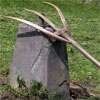
Managing a Compost System
After you have built your compost pile, managing it involves four basic activities, noted below. Click any item below to learn more (show all items).
Monitoring
Monitor Smell

Smelling a rose
- Turn if there are any odors
- Add "browns" if odors persist
- Use a brown layer on top of compost pile. Why? It will absorb odors and discourage flies. Your family, friends,
and visitors will appreciate it.
Monitor Moisture

Watering can
- Add moisture as you BUILD the pile
- Add moisture as you TURN the pile
- If too wet, turn (without adding more water)
- If still too wet, add dry "browns" to pile while turning
Why? Because microbes require moisture to survive, but too much moisture will create odor problems and slow the composting rate.
Monitor Temperature

Thermometer
If you are using a hot composting method:
- Turn if the pile is less than 100 degrees F
- Turn if the pile is more than 150 degrees F
Why? Because thermophilic bacteria prefer temperatures in the 105-140 degrees F range, and these microbes are the fastest at converting raw materials to compost.
If the compost pile exceeds 155 degrees F, give or take, it may be too hot for the bacteria population to thrive. At higher temperatures, the heat may actually kill off part of the population. If this happens, the temperatures will fall off and the populations will slowly rebuild.
Turning and mixing

Pitchfork
The compost pile should be mixed and/or turned periodically, depending on how quickly and completely you want your compost to breakdown. Turning is also the first line of defense for any problems that may occur during the composting process. You can use a pitchfork, shovel or specialized tools for this purpose.
Turning Adds Oxygen
Aerobic composting organisms need oxygen to survive. By building your compost pile with the right balance of greens/browns, providing moisture, and keeping oxygen available to your compost microbes, your pile's temperature will rise and your material will decompose rapidly. Note that shortly after turning, the pile temperature may drop. If the pile is getting "too" hot, you can turn it to help moderate temperature).
Turning Helps Destroy Undesirables
Turning helps destroy weed seeds, insect larvae, and disease-causing organisms by exposing them to the lethal temperatures at the center of the pile. Turning also helps maintain the active population of beneficial microbes by providing more food at the active center of the compost system.
Turning Reduces Odor Problems
Bad odor is an indication that there is an imbalance in your compost system. Turn the pile at the first sign of offensive odor or ammonia smells.
Turning Breaks Up Clumps and Layers
Clumping or matting down can cause pockets in your compost system where oxygen cannot penetrate. These spots can go "anaerobic," which means that microbes that don't need oxygen are doing the work of composting. Anaerobic microbes produce smelly gasses as a by-product of decomposition. Turning breaks up clumps and matted layers in the compost and allows oxygen to penetrate. Therefore, to create a better end product, break up all the clumps of material when turning the compost.
Finishing/curing
Many people wonder how to create finished compost if they are always adding materials to the compost bin. The secret is to make composting a batch process. After a while of composting in one bin, set the compost aside to finish the composting process for "curing" period.

Earthworm
Curing or "finishing" is the process of allowing materials in the compost system to finish the composting process at lower temperatures. Earthworms and other invertebrates will assist with this process. Make sure the compost is moist and aerated during the curing period, which can be as short as one month or as long as a year or more.
While one batch of compost is curing, you can start a second composting bin for your active composting process. In this manner, you can make your compost and use it too!
There are easy compost maturity tests that you can do at home to test if your compost is "finished". See also When is Compost Ready?
Screening

Screening compost
Your composting system may not break down all the larger materials, such as corn cobs or wood chips, in the first batch of compost that you make. When you screen your compost, any material larger than your screen size can be removed. These materials are called "overs," and they can go back into the compost system the next time that you build a pile. The overs provide bulk for aeration, and microbes attached to these pieces will help jump-start the new composting process.
Tricks
As a bonus, to help you get your compost system up and thriving, we've listed some "tricks."
Leaves

Oak leaf
To increase the rate of decomposition, you may break up leaves by running over them with a mower before composting. Also soak leaves and other carbon sources in water overnight before adding them to the compost system.
Store Pitchfork at the Compost Pile
Leave a pitchfork or garden fork in or near the compost pile so you will have it when you need it. Having the tool right there makes it easier to add / bury materials. Most gardeners agree that this strategy helps remind them to use and turn the compost.
Watering
Recruit a friend to spray water on the pile while you turn it - this saves effort and is fun.
Learn More
- Natural Resources

